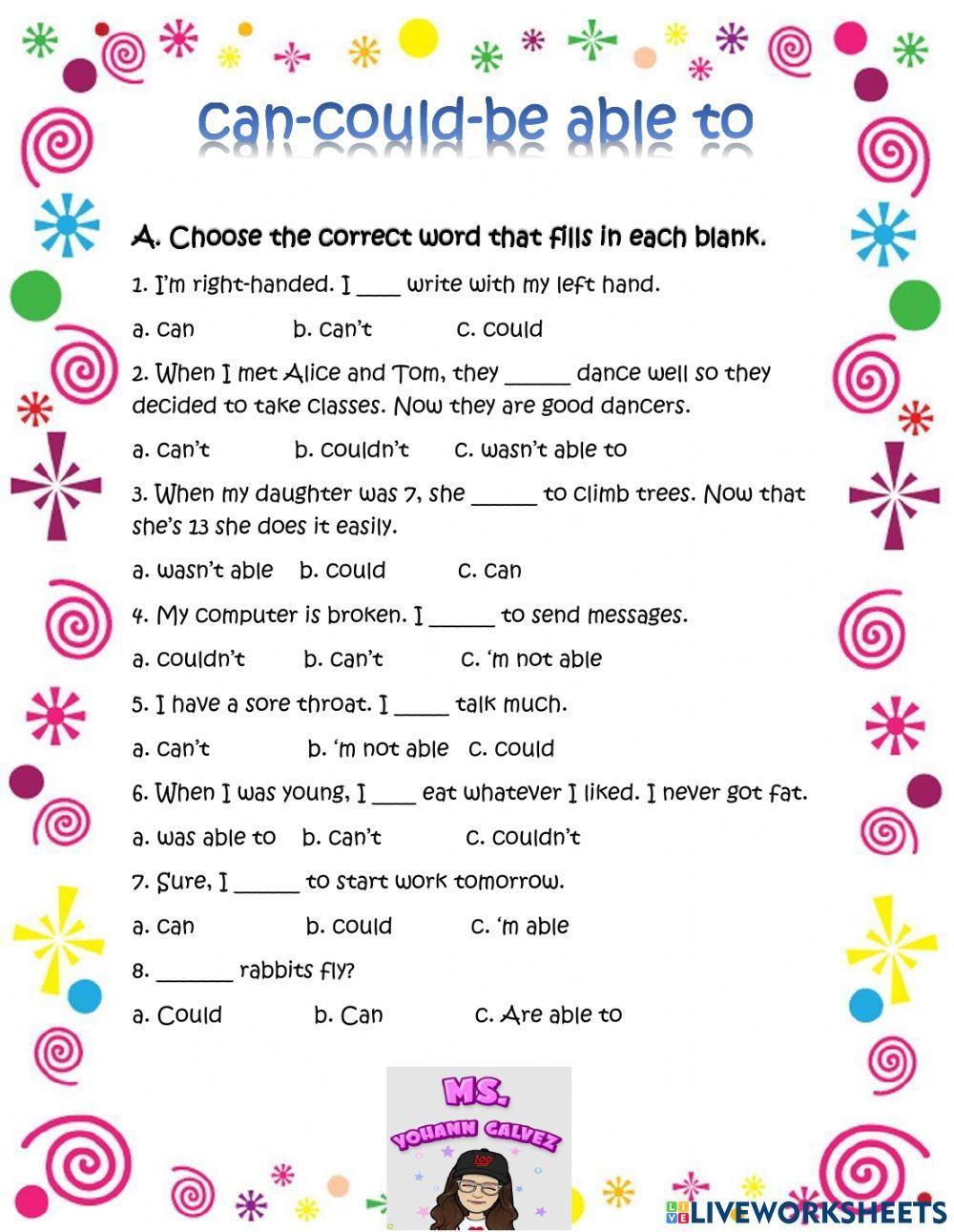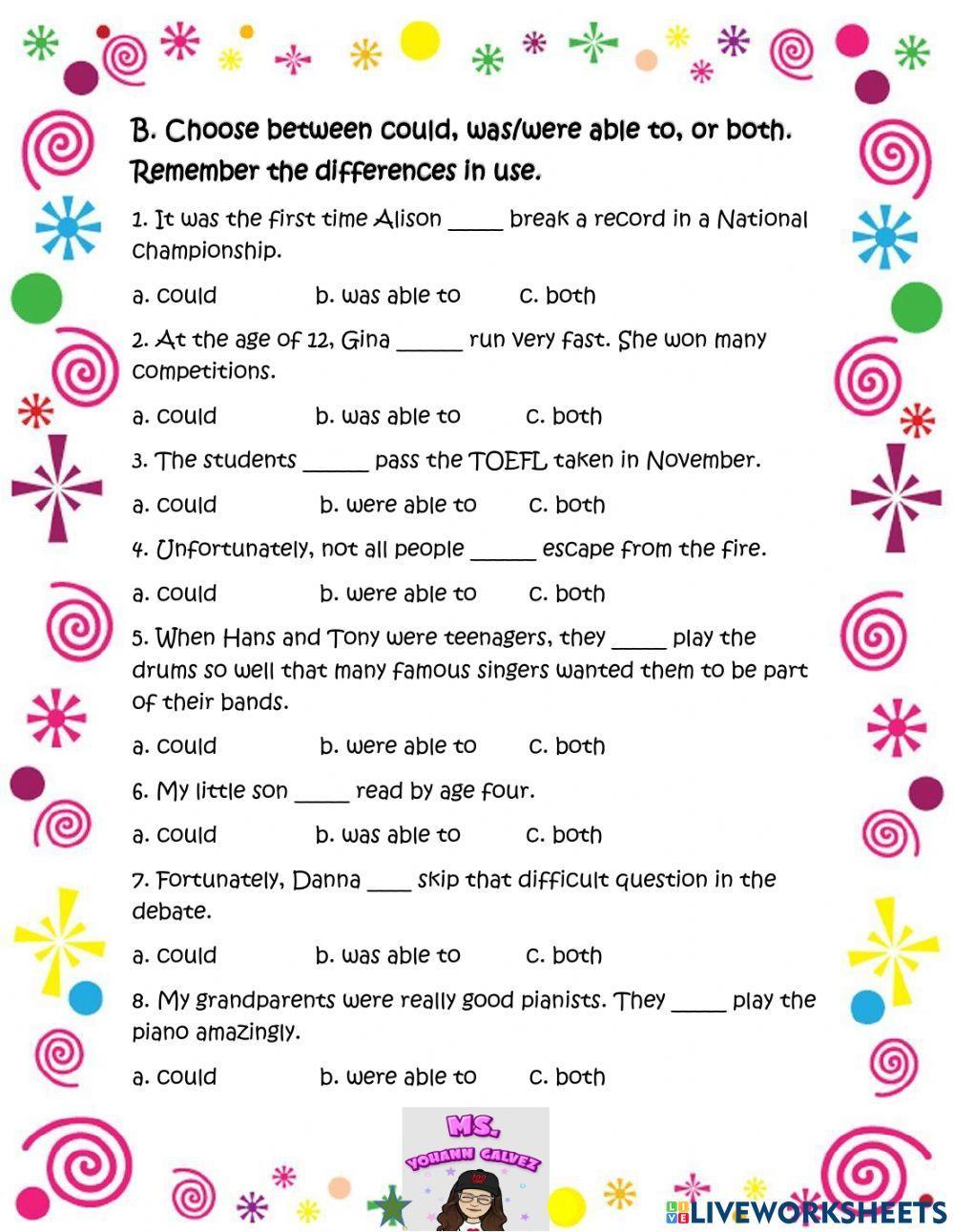Member for
2 years 7 monthsAge: 10+
Level: Basic- Intermediate
Language: English
(en)
ID: 1741865
18/12/2021
Country code: PE
Country: Peru
Main content: Abilities (2012507)
From worksheet author:
This worksheet has the intention to practice the use of can, could, be able to in present and past
Other contents:
present simple - past simple
Worksheet description:
Objective Explanation:
The primary objective of this worksheet is to help students understand and differentiate between the modal verbs "can," "could," and "be able to" in the context of expressing abilities. By engaging with the sentences provided, students will reinforce their ability to choose the appropriate modal verb that best fits the sentence, enhancing their comprehension of English grammar and language usage.
Content Overview:
The worksheet focuses on the concept of abilities, requiring students to apply their knowledge of modal verbs to accurately complete sentences related to various scenarios. Through this exercise, students will practice using "can," "could," and "be able to" in context, ultimately improving their ability to convey different levels of capability in English.
Language and Educational Level Context:
Tailored for students learning English as a Second Language (ESL), this worksheet is designed for learners at an intermediate level of proficiency. By engaging with sentences that reflect real-life situations and abilities, students will enhance their grasp of how to express themselves effectively using the appropriate modal verb in different contexts.
Subject Relevance:
This worksheet directly relates to the broader subject area of English as a Second Language (ESL) by focusing on the linguistic nuances of expressing abilities through modal verbs. As students progress in their language acquisition journey, mastering the usage of modal verbs like "can," "could," and "be able to" is crucial for communicating effectively in various situations both in writing and speaking.
Instructions:
The instructions provided guide students through selecting the correct modal verb to complete each sentence, reinforcing their understanding of when to use "can," "could," or "be able to" based on the context. By presenting sentences that showcase different scenarios, such as writing with a non-dominant hand, learning to dance, climbing trees, or sending messages, students are encouraged to apply their knowledge of modal verbs in practical and relatable contexts for a comprehensive learning experience.
The primary objective of this worksheet is to help students understand and differentiate between the modal verbs "can," "could," and "be able to" in the context of expressing abilities. By engaging with the sentences provided, students will reinforce their ability to choose the appropriate modal verb that best fits the sentence, enhancing their comprehension of English grammar and language usage.
Content Overview:
The worksheet focuses on the concept of abilities, requiring students to apply their knowledge of modal verbs to accurately complete sentences related to various scenarios. Through this exercise, students will practice using "can," "could," and "be able to" in context, ultimately improving their ability to convey different levels of capability in English.
Language and Educational Level Context:
Tailored for students learning English as a Second Language (ESL), this worksheet is designed for learners at an intermediate level of proficiency. By engaging with sentences that reflect real-life situations and abilities, students will enhance their grasp of how to express themselves effectively using the appropriate modal verb in different contexts.
Subject Relevance:
This worksheet directly relates to the broader subject area of English as a Second Language (ESL) by focusing on the linguistic nuances of expressing abilities through modal verbs. As students progress in their language acquisition journey, mastering the usage of modal verbs like "can," "could," and "be able to" is crucial for communicating effectively in various situations both in writing and speaking.
Instructions:
The instructions provided guide students through selecting the correct modal verb to complete each sentence, reinforcing their understanding of when to use "can," "could," or "be able to" based on the context. By presenting sentences that showcase different scenarios, such as writing with a non-dominant hand, learning to dance, climbing trees, or sending messages, students are encouraged to apply their knowledge of modal verbs in practical and relatable contexts for a comprehensive learning experience.
Share / Print Worksheet

